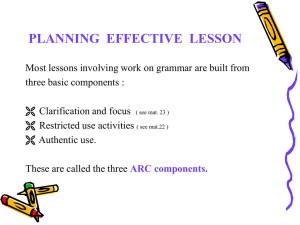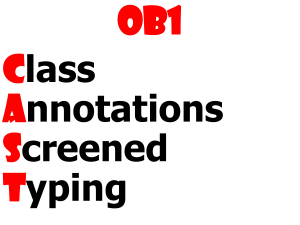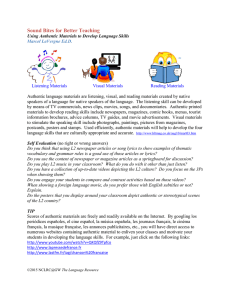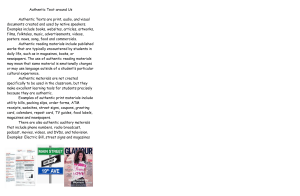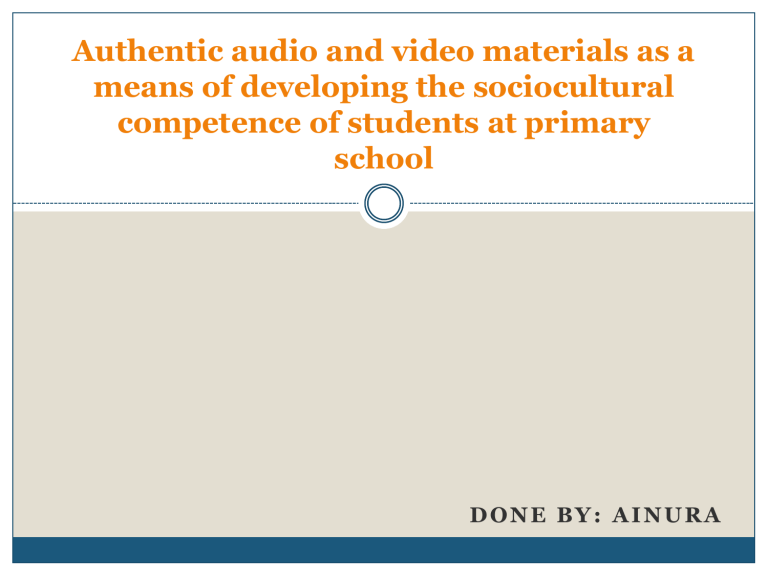
Authentic audio and video materials as a means of developing the sociocultural competence of students at primary school DONE BY: AINURA The relevance of the work • is caused by linguistic and cultural reasons, since authentic materials carry additional information about the country of the language being studied, reveal what is connected with the traditions and customs of the people, with its mentality and behavioral norms. The aim of the work • is to study strategies and technologies for working with authentic audio and video materials, as well as their use in the English class as a way of developing sociocultural competence. Objectives • to consider the features of the formation of socio-cultural competence of students in secondary school; • to describe authentic materials as a means of developing the socio-cultural competence of students in secondary schools; • to develop a set of exercises to work with an authentic audio and video materials for the formation of socio-cultural competence; • to test the developed exercises when working with an authentic audio and video materials to form sociocultural competence in English classes. The socio-cultural competence (SCC) is an essential component of communicative competence. In terms of the internationalization of all aspects of social life the importance of SCC for socialization of modern students and their preparation for intercultural communication at the level is very significant. The content of SCC a) language (authentic vocabulary) 1) socio-cultural knowledge The content of SCC 2) skills and abilities of speech and non speech behavior b) knowledge of certain facts of national culture (national realities, etiquette, folklore elements in its small form) Authentic materials are print, video, and audio materials students encounter in their daily lives, such as change-of-address forms, job applications, menus, voice mail messages, radio programs, and videos. Authentic materials are not created specifically to be used in the classroom, but they make excellent learning tools for students precisely because they are authentic. Unit: What’s this? Episode: What’s this? https://www.youtube.com/watch?v=bg86IRmRmjU&list=PLta2xEUsvl-ua1eEk9XnDW1ajvBpZ1f1&index=14 1. Brainstorming 2. Watch a cartoon and tick () or cross () things A window ____ A pen ____ A book ____ A pencil ____ 3. Work in pairs. Open your bag. Ask and answer A ruler ____ A ball ____ A rubber ____ A notebook ____ Unit: Where’s a ball? Episode: Where’s a ball? https://www.youtube.com/watch?v=RF9YP6jwQdM&list=PLta2xE-Usvl-ua1eEk9XnDW1ajvBpZ1f1&index=21 1. What is «hide and seek»? Do you like to play this game? hide and seek – жасырынбақ 2. Where can we hide? between - арасында behind - артында next to - жанында 3. Complete the text with prepositions 4. Look at the picture again and complete the sentences. Where is the frisbee? – It’s ________ Where is the book? – It’s ________ Where is the ball? – It’s ________ Unit: I like monkeys! I like monkeys! https://www.youtube.com/watch?v=6_bxwvQFCP0&index=5&list=PLta2xE-Usvl-ua1eEk9XnDW1ajvBpZ1f1 Where are the children? Do you like to go to the Zoo? What is your favourite animal? 3. Circle the animals you like. Underline the animals you don’t like. Tiger Monkey Elephant Lion Snake Zebra Giraffe Panda 2. Watch a cartoon and write «T» - true or «F» - false. They see a panda in the Zoo. ___ They see a snake in the Zoo. ___ They see a tiger in the Zoo. ___ They see a lion in the Zoo. ___ They see an elephant in the Zoo. ___ Parrot Goat 4. Draw and write about the animals you like and you don’t like. I like _______________________ I __________________________ I don’t like __________________ I don’t ______________________ I __________________________ Unit: Are these his trousers? Are these his trousers? https://www.youtube.com/watch?v=rudyXzlUhyc&index=28&list=PLta2xE-Usvl-ua1eEk9XnDW1ajvBpZ1f1 1. Repeat the song all together. Every day, I put on my socks, I put on my socks, Every day. Every day, I put on my socks, I put on my shoes, Every day. Every day, I put on my socks, I put on my shoes, I put on my coat, Every day. Every day, I put on my socks, I put on my shoes, I put on my coat, I put on my hat, Every day. 2. Circle the odd-one-out. Write 3. Watch a cartoon and complete the sentences ‘s Jenny socks ‘s blouse •It’s ______’s dress. •It’s father __ shirt. •It’s Jenny __ skirt. •These are Tony’s _______. •It’s Jenny’s_______. Histogram comparative analysis of the results of primary and control listening, % 100% 90% 80% 70% 60% primary 50% control 40% 30% 20% 10% 0% Student 1 Student 2 Student 3 Student 4 Student 5 Student 6 Student 7 Conclusion Based on the research we have done, a great potential of teaching English based on authentic feature films has been identified, which is realized through the visibility of video materials, their relevance to reality, the creation of speech situations based on video materials that are closest to the real, aesthetic function of cinema. The effectiveness of the methodology was tested in the course of experimental work on the basis of secondary school. The results of the experiment revealed high levels of reading skill development among the students of the experimental group, against the background of the average indicators of the students of the control group who were engaged in a different method. As a result of the study, it was found that the pedagogical potential of the methodology of teaching English based on authentic materials can be realized through an educational and methodological complex, supplemented by feature films and other authentic video materials, forms of working with them, tasks for each video sequence. THANK YOU FOR YOUR ATTENTION!
